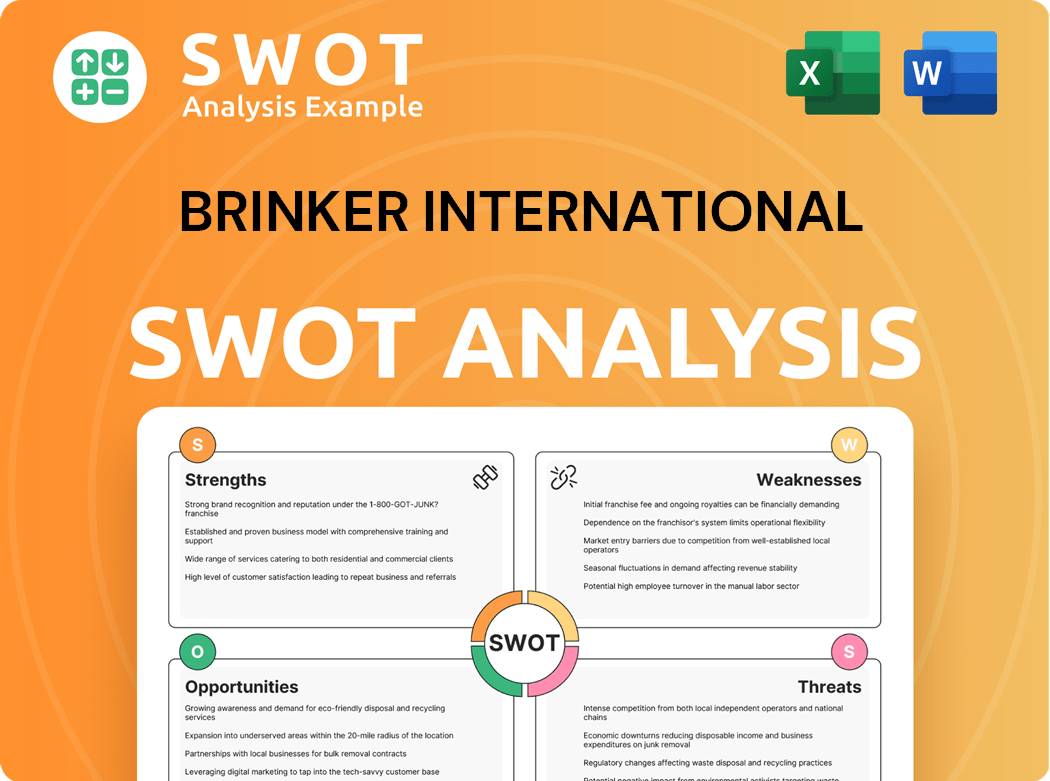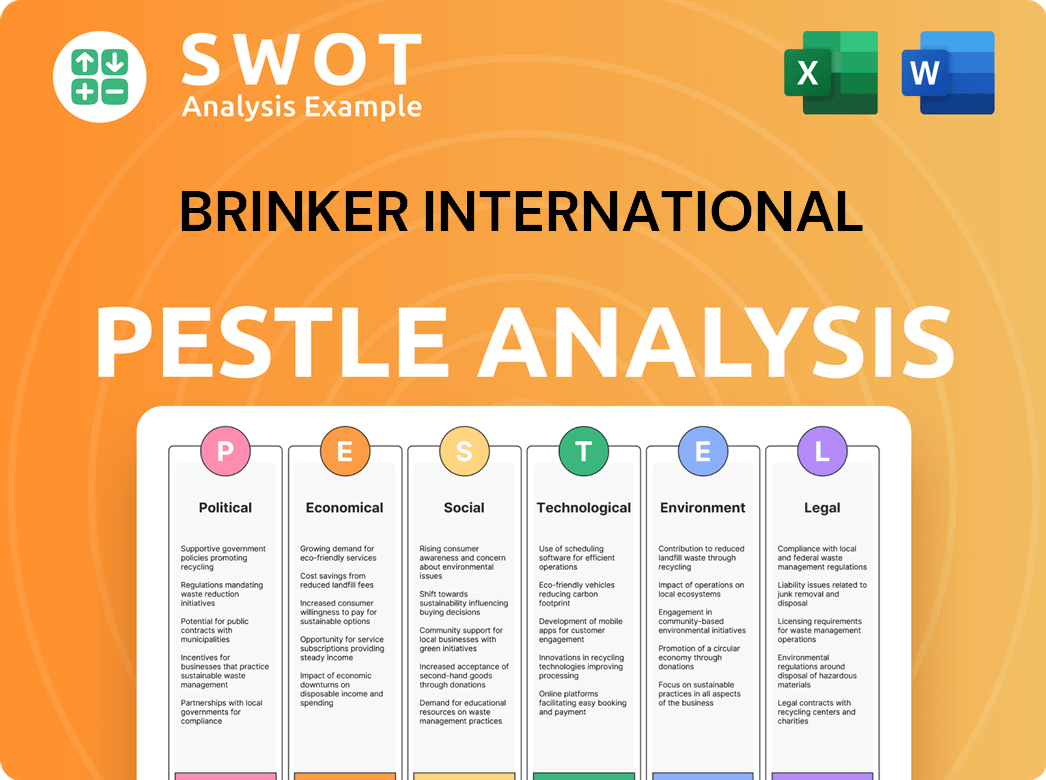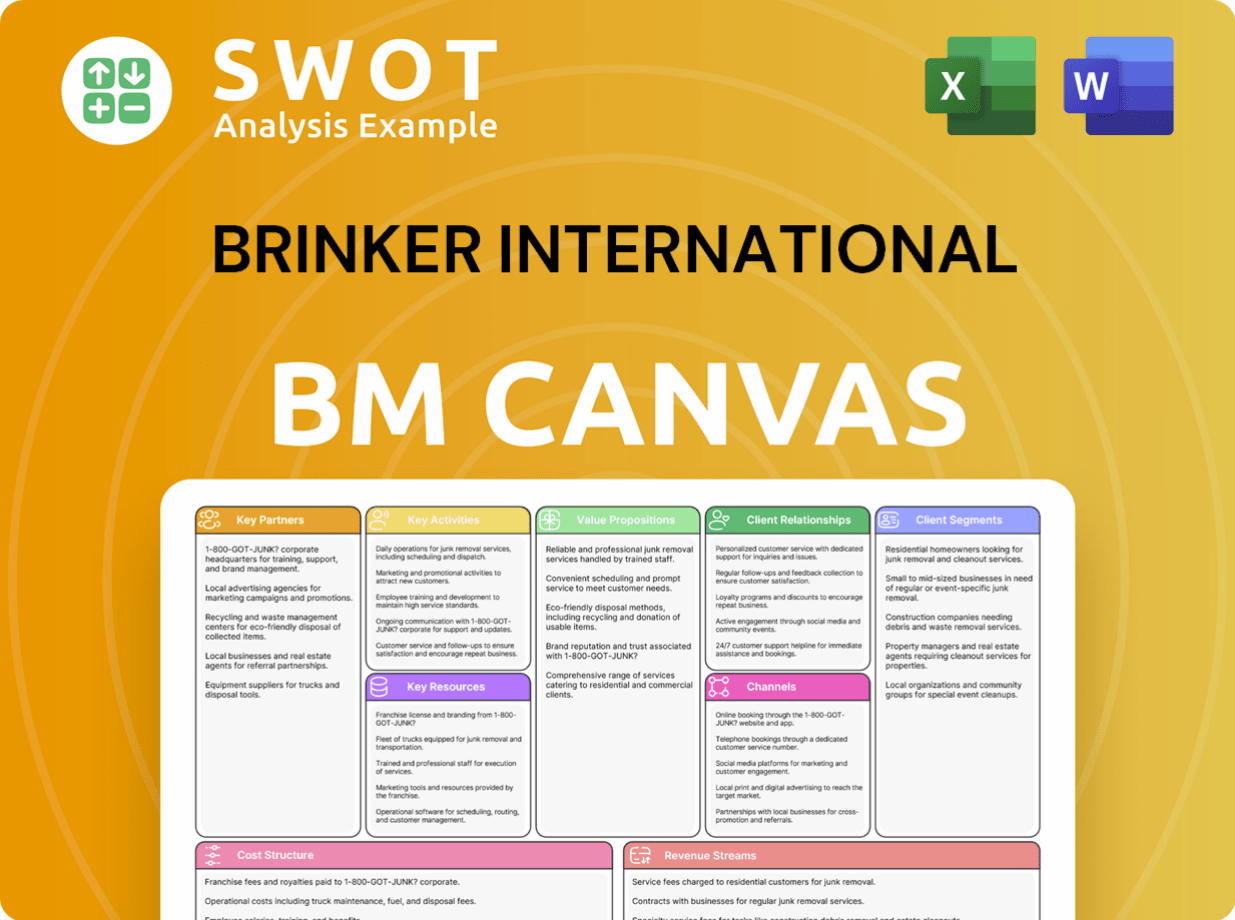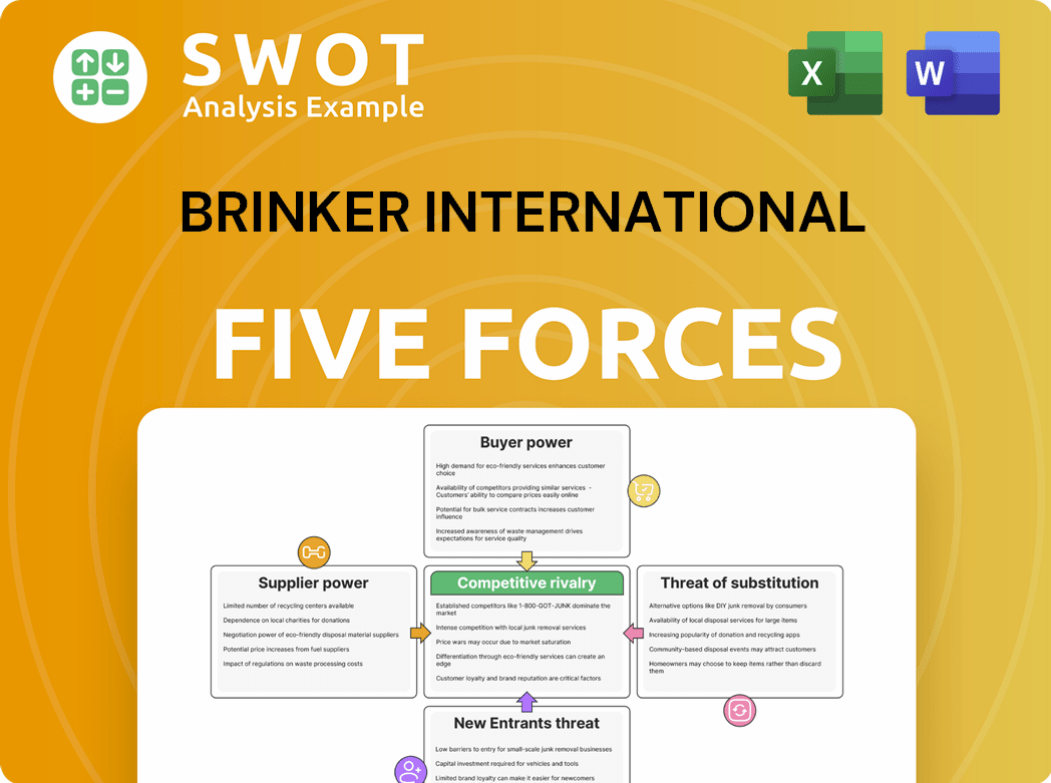Brinker International Bundle
How Did Brinker International Become a Global Restaurant Giant?
From a single burger joint in Dallas to a global powerhouse, Brinker International's story is a testament to strategic vision and enduring appeal. Founded in 1975 as Chili's Bar & Grill, the company has navigated decades of change to become a leading force in casual dining. This journey reveals how a simple idea can transform into a multi-billion dollar enterprise, shaping the landscape of the restaurant industry.

Understanding the Brinker International SWOT Analysis is crucial for grasping the company's current position and future prospects. The brief history of Chili's Grill & Bar, and its evolution into Brinker International, highlights key milestones and strategic decisions. This exploration of the Brinker history will uncover the early days of Brinker International, its expansion strategies, and the challenges it overcame to become a prominent restaurant company.
What is the Brinker International Founding Story?
The Brinker International story begins in March 1975. It started with the opening of the first Chili's Grill & Bar in Dallas, Texas, by Larry Lavine. This marked the genesis of a restaurant company that would grow into a significant player in the casual dining sector.
Lavine's vision was to create a relaxed dining spot. It would be known for its hamburgers and affordable prices. This simple yet effective concept proved highly successful, leading to rapid expansion in the late 1970s and early 1980s. The company's timeline is marked by key strategic decisions and acquisitions.
In 1976, the company was officially renamed Chili's Inc. A major turning point came in 1983 when Norman E. Brinker acquired the Chili's chain. His leadership was instrumental in shaping the company's future.
The initial Chili's concept focused on casual dining. It offered bold flavors and large portions. Norman Brinker's acquisition and subsequent public offering in 1984 fueled further expansion.
- Early Days of Brinker International: Larry Lavine opened the first Chili's Grill & Bar in 1975 in Dallas, Texas.
- Rapid Expansion: By the early 1980s, there were over 20 Chili's restaurants.
- Norman Brinker's Influence: He acquired the chain in 1983 and took it public in 1984.
- Public Offering: The 1984 IPO provided capital for further growth.
Norman Brinker, often called the 'godfather of the restaurant industry,' brought extensive experience. He had previously founded Steak and Ale and led The Pillsbury Restaurant Group. His acquisition of Chili's, then comprising 23 restaurants across six states, was a pivotal moment. Brinker aimed to transform Chili's into a diversified restaurant portfolio company. This strategic move set the stage for Brinker International's future growth.
The original business model focused on a 'come as you are' atmosphere. It featured bold flavors, quality ingredients, and Texas-sized portions. This approach resonated with customers and contributed to the chain's early success. The 1984 public offering was a crucial step in the Brinker history, providing the necessary capital for expansion. This early focus on casual dining and customer experience helped establish the brand.
As Brinker International expanded, it faced competition. Understanding the Competitors Landscape of Brinker International is crucial for assessing its market position. The company's early decisions, from the initial menu to the acquisition by Norman Brinker, shaped its trajectory. These decisions laid the foundation for what Brinker International is today.
Brinker International SWOT Analysis
- Complete SWOT Breakdown
- Fully Customizable
- Editable in Excel & Word
- Professional Formatting
- Investor-Ready Format

What Drove the Early Growth of Brinker International?
Following Norman Brinker's acquisition in 1983, the restaurant company, formerly known as Chili's Inc., initiated a period of significant expansion. This growth included diversification beyond the initial brand, with the introduction of new dining concepts. The company's evolution culminated in a name change to Brinker International, reflecting its expanding portfolio and ambitions within the casual dining sector.
By 1984, the 23 Chili's restaurants generated $40 million in sales, demonstrating early success. A key milestone was the opening of the first Romano's Macaroni Grill in Leon Springs, Texas, in 1988. This marked a strategic move to diversify the company's offerings beyond the Chili's brand, introducing an Italian dining concept.
In 1991, Chili's Inc. officially became Brinker International, Inc., signaling its broader ambitions. By the end of 1991, sales reached $426.8 million, with earnings of $26.1 million. The company experienced rapid expansion, opening approximately one new restaurant per week by the spring of 1992, achieving a 23 percent sales growth rate.
Brinker International expanded internationally in 1992, entering an agreement to bring the Chili's brand to the Far East. A significant acquisition occurred in August 1995 with the purchase of Maggiano's Little Italy, further strengthening its multi-brand strategy. By 1995, the company had grown to over 1,400 restaurants worldwide.
Norman Brinker stepped down as company chairman in 2000. Wyman Roberts was elected CEO and President in November 2012, holding the position until his retirement in June 2022, when Kevin Hochman succeeded him. The company strategically refined its brand portfolio, divesting Corner Bakery Cafe, Romano's Macaroni Grill, and On the Border Mexican Grill & Cantina at different times.
Brinker International PESTLE Analysis
- Covers All 6 PESTLE Categories
- No Research Needed – Save Hours of Work
- Built by Experts, Trusted by Consultants
- Instant Download, Ready to Use
- 100% Editable, Fully Customizable

What are the key Milestones in Brinker International history?
The history of Brinker International is marked by significant achievements, from pioneering concepts in casual dining to navigating a competitive market. The restaurant company has evolved significantly since its inception, adapting to changing consumer preferences and economic conditions. Understanding the Owners & Shareholders of Brinker International is crucial for grasping the company's strategic direction and financial health.
| Year | Milestone |
|---|---|
| Early Days | Norman Brinker introduced the salad bar at Steak and Ale, a precursor to his later innovations. |
| 1975 | Chili's Grill & Bar was founded, establishing a 'come as you are' atmosphere, bold flavors, and value-oriented menus. |
| Ongoing | Brinker International pioneered the multi-brand restaurant portfolio, a concept that set it apart in the casual dining sector. |
| 2023 | Digital sales represented 44% of total sales, highlighting the company's focus on technological advancements. |
| Q3 FY2025 | Chili's comparable sales increased by 31.6%, demonstrating strong recent performance. |
Brinker International has consistently embraced innovation to stay ahead of the curve. The company's emphasis on a 'come as you are' atmosphere and value-driven menus at Chili's was a groundbreaking move in the casual dining segment. Furthermore, the company has invested in new kitchen technology, such as Turbochef ovens, to speed up service times and enhance operational efficiency.
Norman Brinker's introduction of the salad bar at Steak and Ale revolutionized casual dining, offering customers a new dining experience. This innovation set a precedent for future developments within the company.
Chili's established a 'come as you are' atmosphere, creating a welcoming environment for customers. This approach helped differentiate the brand in the competitive casual dining market.
Brinker International pioneered the concept of a multi-brand restaurant portfolio, allowing for diversification and broader market coverage. This strategy helped to mitigate risks associated with relying on a single brand.
The company has enhanced its digital ordering infrastructure, with digital sales significantly contributing to total sales. This focus on technology improves customer convenience and operational efficiency.
Investments in new kitchen technology, such as Turbochef ovens, speed up service times. This improves customer satisfaction and operational efficiency.
The evolution of Chili's menu, with bold flavors and value-oriented options, has been a key factor in attracting and retaining customers. This continuous adaptation to changing consumer tastes keeps the brand relevant.
Despite its successes, Brinker International faces several challenges. The casual dining sector is highly competitive, and the company is dependent on its key brands, particularly Chili's. Additionally, rising labor and food costs pose persistent financial pressures.
The casual dining sector is highly competitive, with numerous restaurants vying for customer attention. This requires continuous innovation and strategic adaptation to maintain market share.
Brinker International's reliance on its primary brands, particularly Chili's, makes it vulnerable to fluctuations in those brands' performance. Diversification and strategic brand management are crucial.
Rising labor and food costs impact profit margins, requiring careful cost management and pricing strategies. In fiscal year 2023, food costs increased by 4.7% and labor costs rose by 3.2%.
Brinker's gross profit margin was 19.57% as of March 31, 2025, which is considered low compared to its peers. Improving profitability requires effective cost controls and revenue strategies.
Analysts question the sustainability of high growth rates, projecting a slowdown in the fourth quarter of fiscal year 2025. Managing expectations and ensuring long-term growth is essential.
The company's stock valuation has become sensitive to comparable sales trends, and increased capital expenditures for modernization could pressure financials in the short term. Maintaining investor confidence is critical.
Brinker International Business Model Canvas
- Complete 9-Block Business Model Canvas
- Effortlessly Communicate Your Business Strategy
- Investor-Ready BMC Format
- 100% Editable and Customizable
- Clear and Structured Layout

What is the Timeline of Key Events for Brinker International?
The Brinker International company has a rich history, starting with the opening of the first Chili's Grill & Bar in March 1975. The company, which began as Chili's Inc., went public in 1984 and later became Brinker International, Inc. in 1991. Throughout its history, Brinker has expanded its portfolio through acquisitions and strategic partnerships, evolving into a significant player in the casual dining sector.
| Year | Key Event |
|---|---|
| March 1975 | Larry Lavine opens the first Chili's Grill & Bar in Dallas, Texas. |
| 1976 | The company is renamed Chili's Inc. |
| 1983 | Norman E. Brinker acquires Chili's Inc. |
| 1984 | Chili's Inc. goes public. |
| 1988 | The first Romano's Macaroni Grill opens. |
| 1991 | Chili's Inc. becomes Brinker International, Inc. |
| 1992 | Brinker expands Chili's to the Far East through an agreement with Pac-Am Food Concepts. |
| August 1995 | Brinker acquires Maggiano's Little Italy. |
| 2000 | Norman Brinker steps down as company chairman. |
| 2005 | Brinker sells Corner Bakery Cafe. |
| 2008 | Brinker sells a majority interest in Romano's Macaroni Grill. |
| June 2010 | Brinker sells On the Border Mexican Grill & Cantina. |
| January 1, 2013 | Wyman Roberts becomes CEO and President of Brinker International. |
| 2019 | Brinker acquires 116 franchised Chili's restaurants. |
| 2021 | Brinker acquires an additional 23 franchised Chili's restaurants. |
| June 2022 | Kevin Hochman succeeds Wyman Roberts as CEO and President. |
| June 2024 | CFO Joe Taylor retires and is succeeded by Mika Ware. |
For fiscal year 2025, Brinker International anticipates total revenues between $5.33 billion and $5.35 billion. Net income per diluted share, excluding special items, is projected to be between $8.50 and $8.75. The company plans capital expenditures of $265 million to $275 million, focusing on asset modernization and technology upgrades.
Brinker International is investing in marketing and operational improvements. These efforts have led to significant traffic growth, particularly for Chili's, with a 31.6% increase in comparable restaurant sales in the third quarter of fiscal year 2025. Traffic rose by 21% during this period.
The high growth rate for Chili's may slow down, with guidance suggesting a decrease to the low-20% range in Q4 fiscal year 2025. Rising labor costs and potential economic headwinds pose additional challenges. Despite these issues, the company maintains a strong financial health score.
Brinker International's future strategy will likely focus on enhancing the guest experience, optimizing core brands, and disciplined capital management. The company aims to continue providing quality dining experiences in a casual atmosphere, staying true to its original vision.
Brinker International Porter's Five Forces Analysis
- Covers All 5 Competitive Forces in Detail
- Structured for Consultants, Students, and Founders
- 100% Editable in Microsoft Word & Excel
- Instant Digital Download – Use Immediately
- Compatible with Mac & PC – Fully Unlocked

Related Blogs
- What is Competitive Landscape of Brinker International Company?
- What is Growth Strategy and Future Prospects of Brinker International Company?
- How Does Brinker International Company Work?
- What is Sales and Marketing Strategy of Brinker International Company?
- What is Brief History of Brinker International Company?
- Who Owns Brinker International Company?
- What is Customer Demographics and Target Market of Brinker International Company?
Disclaimer
All information, articles, and product details provided on this website are for general informational and educational purposes only. We do not claim any ownership over, nor do we intend to infringe upon, any trademarks, copyrights, logos, brand names, or other intellectual property mentioned or depicted on this site. Such intellectual property remains the property of its respective owners, and any references here are made solely for identification or informational purposes, without implying any affiliation, endorsement, or partnership.
We make no representations or warranties, express or implied, regarding the accuracy, completeness, or suitability of any content or products presented. Nothing on this website should be construed as legal, tax, investment, financial, medical, or other professional advice. In addition, no part of this site—including articles or product references—constitutes a solicitation, recommendation, endorsement, advertisement, or offer to buy or sell any securities, franchises, or other financial instruments, particularly in jurisdictions where such activity would be unlawful.
All content is of a general nature and may not address the specific circumstances of any individual or entity. It is not a substitute for professional advice or services. Any actions you take based on the information provided here are strictly at your own risk. You accept full responsibility for any decisions or outcomes arising from your use of this website and agree to release us from any liability in connection with your use of, or reliance upon, the content or products found herein.